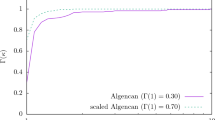Abstract
We present two strategies for choosing a “hot” starting-point in the context of an infeasible potential reduction (PR) method for convex quadratic programming. The basic idea of both strategies is to select a preliminary point and to suitably scale it in order to obtain a starting point such that its nonnegative entries are sufficiently bounded away from zero, and the ratio between the duality gap and a suitable measure of the infeasibility is small. One of the two strategies is naturally suggested by the convergence theory of the PR method; the other has been devised to reduce the initial values of the duality gap and the infeasibility measure, with the objective of decreasing the number of PR iterations. Numerical experiments show that the second strategy generally performs better than the first, and both outperform a starting-point strategy based on the affine-scaling step.
Similar content being viewed by others
References
Byrd R., Nocedal J., Waltz R.: KNITRO: an integrated package for nonlinear optimization. In: Di Pillo, G., Roma, M. Large-Scale Nonlinear Optimization, pp. 35–59. Springer, Berlin (2006)
Cafieri S., D’Apuzzo M., De Simone V., di Serafino D.: On the iterative solution of KKT systems in potential reduction software for large-scale quadratic problems. Comput. Optim. Appl. 38, 27–45 (2007)
Cafieri S., D’Apuzzo M., De Simone V., di Serafino D.: Stopping criteria for inner iterations in inexact Potential Reduction methods: a computational study. Comput. Optim. Appl. 36, 165–193 (2007)
Cafieri S., D’Apuzzo M., De Simone V., di Serafino D., Toraldo G.: Convergence analysis of an inexact potential reduction method for convex quadratic programming. J. Optim. Theory Appl. 135, 355–366 (2007)
Cafieri, S., D’Apuzzo, M., De Simone, V., di Serafino, D.: On the use of an approximate constraint preconditioner in a potential reduction algorithm for quadratic programming. In: Cutello, V., Fotia, G., Puccio, L. (eds.) Applied and Industrial Mathematics in Italy II, Series on Advances in Mathematics for Applied Sciences, vol. 75, pp. 220–230. World Scientific, Singapore (2007)
Cafieri S., D’Apuzzo M., Marino M., Mucherino A., Toraldo G.: Interior point solver for large-scale quadratic programming problems with bound constraints. J. Optim. Theory Appl. 129, 55–75 (2006)
D’Apuzzo, M., De Simone, V., di Serafino, D.: On mutual impact of numerical linear algebra and large-scale optimization with focus on interior point methods. Comput. Optim. Appl. (2008). doi:10.1007/s10589-008-9226-1
Dolan E.D., Moré J.J.: Benchmarking optimization software with performance profiles. Math. Program. 91, 201–213 (2002)
Gertz E.M., Nocedal J., Sartenaer A.: Starting-point strategy for nonlinear interior methods. Appl. Math. Lett. 17, 945–952 (2004)
Gould N.I.M., Orban D., Toint P.L.: CUTEr (and SifDec), a constrained and unconstrained testing environment, revisited. ACM Trans. Math. Softw. 29, 373–394 (2003)
Gertz, E.M., Wright, S.J.: Object-oriented software for quadratic programming. ACM Trans. Math. Softw. 29, 58–81 (2003). See also http://www.cs.wisc.edu/~swright/ooqp/
Mehrotra S.: On the implementation of a primal-dual interior point method. SIAM J. Optim. 2, 575–601 (1992)
Mizuno S., Kojima M., Todd M.J.: Infeasible-interior-point primal-dual potential-reduction algorithms for linear programming. SIAM J. Optim. 5, 52–67 (1995)
Vanderbei R.J.: An interior point code for quadratic programming. Optim. Methods Softw. 1, 451–484 (1999)
Wright S.J.: Primal-dual interior-point methods. SIAM, Philadelphia (1997)
Author information
Authors and Affiliations
Corresponding author
Rights and permissions
About this article
Cite this article
D’Apuzzo, M., De Simone, V. & di Serafino, D. Starting-point strategies for an infeasible potential reduction method. Optim Lett 4, 131–146 (2010). https://doi.org/10.1007/s11590-009-0150-9
Received:
Accepted:
Published:
Issue Date:
DOI: https://doi.org/10.1007/s11590-009-0150-9




